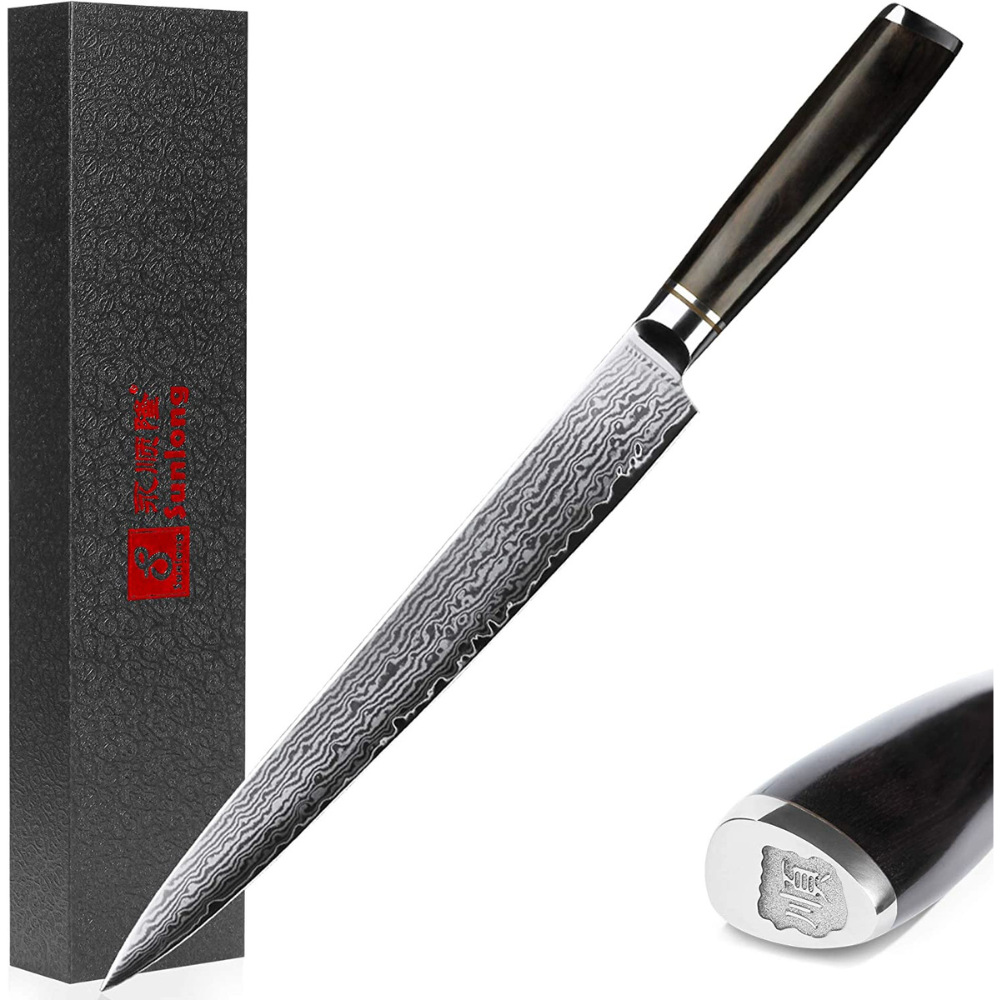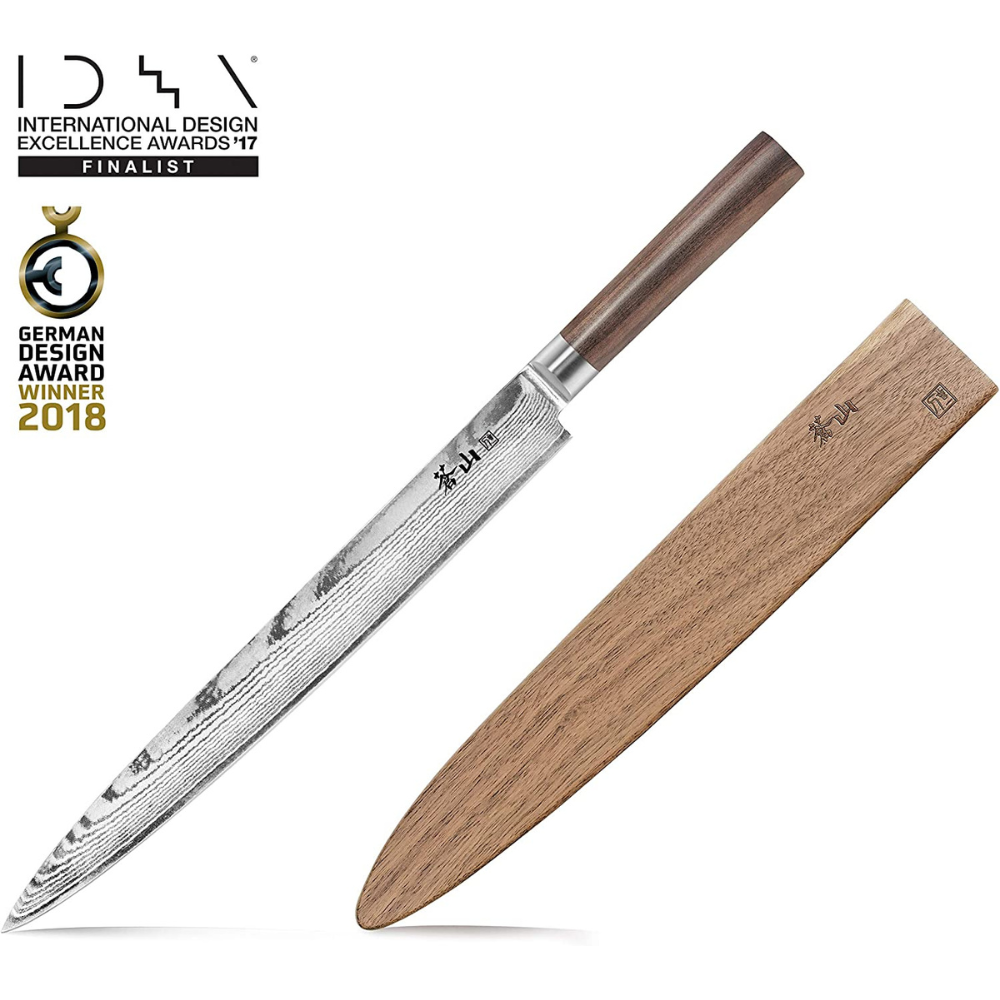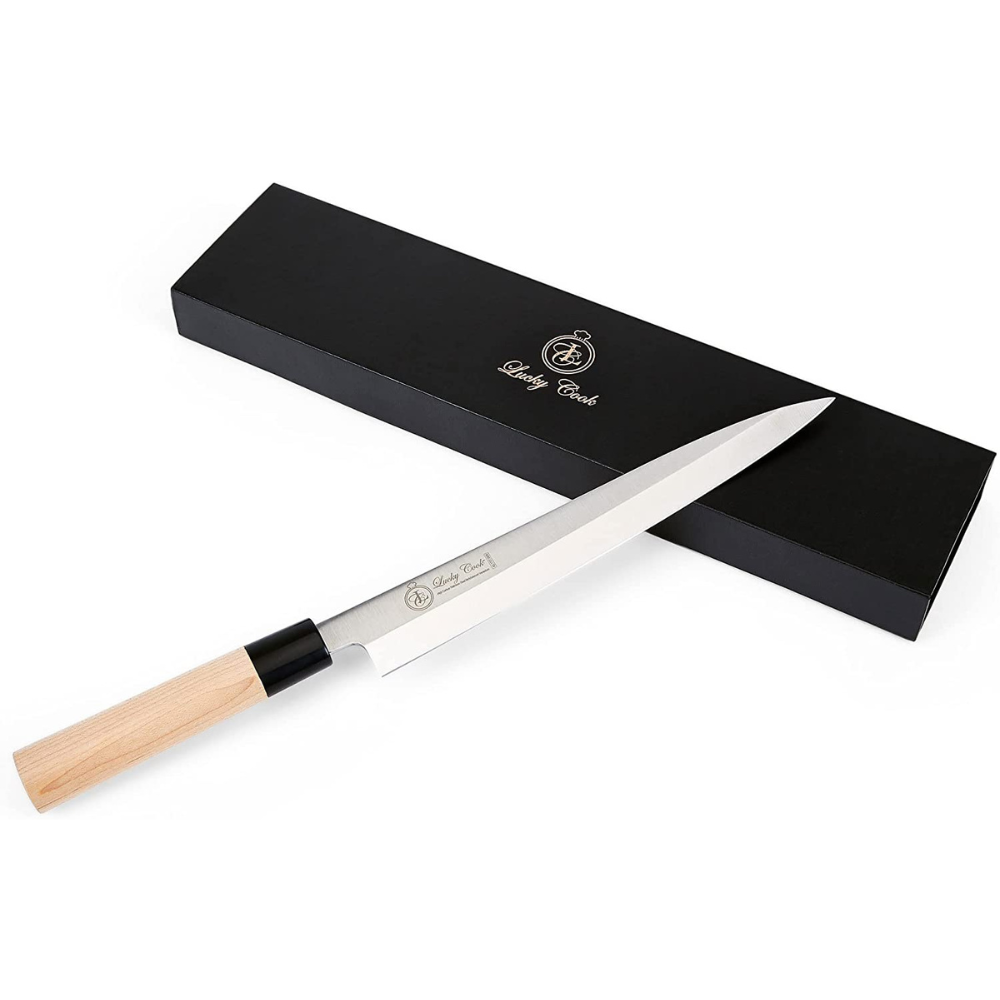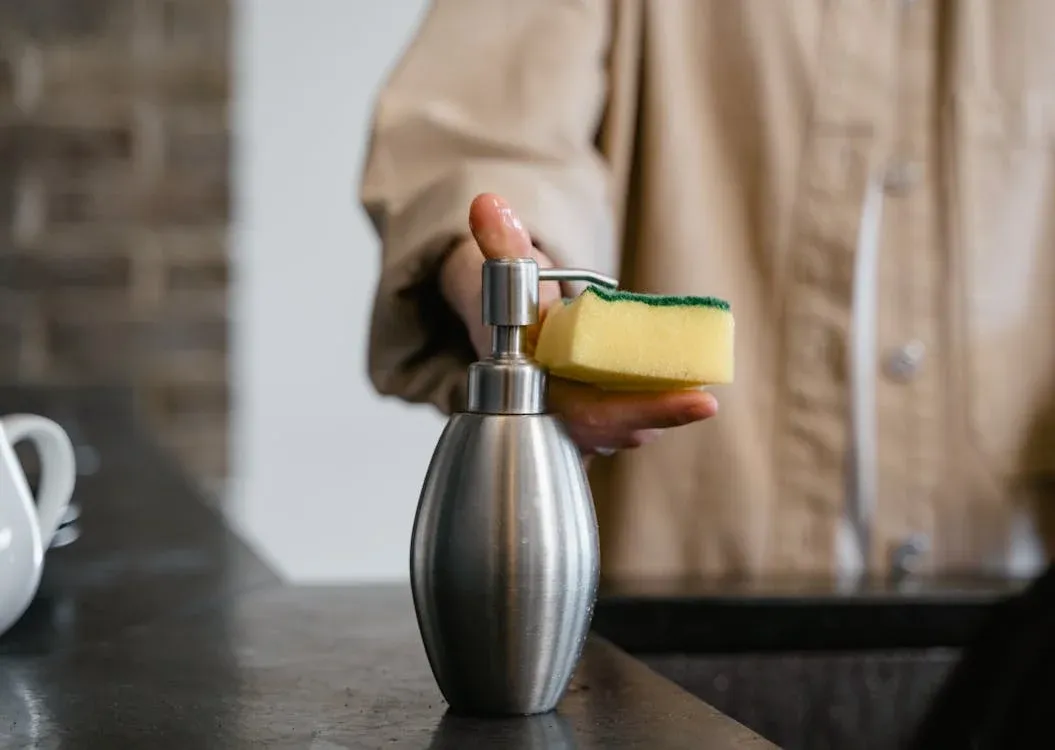Hey there! Ever found yourself wrestling with a roll of sushi, trying to get that perfect slice but ending up with a squished mess instead? I totally get it. That's exactly why I went on a mission to find the best sushi knives out there. And guess what? I found five amazing ones that will change your sushi game forever. These knives are not just sharp; they're like a secret weapon for your kitchen, making slicing sushi feel effortlessly cool. So, are you ready to transform your sushi nights and impress everyone? Let's check out these awesome finds together!
🤝As an Amazon Associate and affiliate with other networks, we earn from qualifying purchases made through our links, at ZERO additional cost to you.
5 Best Sushi Knives: Yanagiba
- Best Overall: Dalstrong
- Editor's Choice: Sunlong
- Best Splurge: Cangshan
- Best for Sushi Enthusiasts: Lucky Cook
- Best on a Budget: Kitchen + Home Non-Stick Sushi Knife
1. Best Overall

Dalstrong
Dalstrong combines exceptional quality, precision, and durability. It's crafted from high-carbon German steel, offering a perfect balance of performance and aesthetics. Its versatility and 100% satisfaction guarantee make it an outstanding choice for most users.
What We Love
- Exceptional Quality: Crafted from high-carbon German steel, Dalstrong knives offer unparalleled sharpness and durability.
- Precision Cutting: Ideal for both professional chefs and cooking enthusiasts, ensuring perfect cuts every time.
- Ergonomic Design: Features a comfortable grip for outstanding control and precision.
- Risk-Free Purchase: Comes with a 100% money-back guarantee for complete satisfaction.
- Safe Storage: Includes a protective polymer sheath for safety and longevity.
What to Keep in Mind
- Specialized Use: Primarily designed for slicing, particularly sushi and sashimi, which may not suit all cooking needs.
Why It Might Be Right for You
If you're seeking a knife that meets the demands of both professional and home kitchens, Dalstrong is your go-to choice. Its versatility shines whether you're crafting delicate sushi rolls or slicing through robust sashimi. The blend of German engineering and ergonomic design ensures that every cut is a testament to precision, making your culinary creations not just meals, but masterpieces.
Customer Review (source: Amazon)
I recently started learning sushi making and chose this Dalstrong knife. It arrived in a special box, reflecting the pride they have in their product. The knife's well-made, with a nice heft and sharpness, though I touched it up a bit for my preference. The handle's craftsmanship is impressive, with no mismatch in the rivets and tang. It's an excellent purchase that has me interested in more Dalstrong products.
2. Editor's Choice

Sunlong
Sunlong stands out for its unique blend of style and functionality. The Damascus pattern, high-quality VG-10 steel, and ebony handle make it an exceptional choice for those who appreciate a knife that is both a high-performing tool and a work of art.
What We Love
- Elegant Damascus Design: 66 layers of stainless steel create a stunning, durable blade.
- Unique Dual Texture: One side features a Damascus pattern, the other a hammered texture for reduced drag and minimal food sticking.
- High-Quality Material: Crafted with VG-10 steel, ensuring longevity and reliability.
- Versatile Use: Ideal for slicing raw fish and seafood, perfect for sashimi preparation.
- Comfortable Grip: The black ebony wood handle offers both style and a comfortable hold.
What to Keep in Mind
- Specialized Slicing: Excellently suited for slicing but not recommended for chopping tasks.
Why It Might Be Right for You
Sunlong is the perfect blend of artistic design and practical functionality. If you appreciate the beauty in your tools and want a knife that stands out in both performance and appearance, this is your ideal choice. Every slice with this Damascus steel knife is a celebration of both tradition and innovation, making your sushi preparation an experience to cherish.
Customer Review (source: Amazon)
This knife exceeded my expectations considering its price. It maintains its edge, features a flawlessly executed single bevel, and its balance ensures smooth, damage-free cuts in fresh tuna. A quick hone before use ensures its performance keeps me satisfied.
3. Best Splurge

Cangshan
As the most expensive option, Cangshan is the best splurge. It's an investment in top-tier craftsmanship, design, and materials. The special formula Cangshan X-7 Damascus steel and its award-winning design make it a luxurious choice for those who prioritize quality and aesthetics in their culinary tools.
What We Love
- Exceptional Craftsmanship: Handcrafted by skilled bladesmiths, ensuring both beauty and quality.
- Award-Winning Design: Winner of the 2017 Red Dot Design Award, showcasing its outstanding design.
- Superior Balance and Performance: Perfectly balanced for exceptional control and comfort in use.
- Durable and Sharp: Forged from Cangshan X-7 Damascus steel for durability, stain resistance, and edge retention.
- Elegant Sheath: Comes with a fitted dark walnut wood magnetic Saya style sheath, adding to its elegance and safety.
What to Keep in Mind
- Special Care Required: As with any high-quality knife, proper maintenance and careful handwashing are necessary to maintain its condition.
Why It Might Be Right for You
For the culinary connoisseur who values both form and function, the Cangshan knife is a symbol of luxury and high performance. Its exquisite design and superior Damascus steel blade are not just about making food; they're about making a statement. This knife is for those who view their kitchen not just as a place to cook, but as a canvas for culinary art.
Customer Review (source: Amazon)
As a professional sushi chef, I've found this knife to be one of the best in my arsenal, significantly outperforming the Mercers we previously used. Its impressive cutting ability was demonstrated when an apple, dropped onto the blade, split effortlessly. I'd definitely purchase it again.
4. Best for Sushi Enthusiasts

Lucky Cook
The Lucky Cook sushi knife is perfect for home chefs passionate about making sushi. Its ergonomic design, right-handed asymmetric blade, and ease of use make it an excellent choice for those who enjoy preparing sushi at home, offering professional-grade precision in a user-friendly format.
What We Love
- Professional Sushi Making: Long, narrow, right-handed asymmetric blade for expert filleting.
- Comfortable Handle: Slightly oval, natural wood handle for a comfortable and secure grip.
- Efficient and Convenient: Ideal for slicing large quantities without fatigue.
- Eco-Friendly and Safe: A responsible choice for environmentally conscious cooks.
- Versatile Use: Perfect for slicing sushi, sashimi, and a variety of produce.
What to Keep in Mind
- Specialized Design: Primarily tailored for right-handed users and specific slicing tasks.
Why It Might Be Right for You
The Lucky Cook sushi knife is tailored for the home chef who loves the art of sushi making. Its ergonomic design and user-friendly features make sushi preparation at home a joy, not a chore. Whether you're a seasoned sushi maker or just starting out, this knife will make you feel like a pro in your own kitchen, turning each sushi session into a delightful culinary adventure.
Customer Review (source: Amazon)
For its price, this knife delivers good value, providing decent sushi and sashimi slices, even though it can't match the precision of my personal $200 sushi knife. It's a suitable choice for home sushi making, as I've experienced with my daughter in Hawaii.
5. Best on a Budget

Kitchen + Home Non-Stick Sushi Knife
Offering great value, this knife is perfect for those on a budget. Its high-quality surgical stainless steel, nonstick Teflon coating, and versatility across various foods make it an excellent choice for cost-conscious consumers seeking quality.
What We Love
- High-Quality Design: Crafted with surgical stainless steel for flexibility and precise cuts.
- Innovative Nonstick Coating: PFOA-free Teflon coating and aerated blade design reduce sticking and friction.
- Versatile Cutting Tool: Ideal for slicing raw fish, vegetables, meats, sushi, and cheeses with ease.
- Efficient and User-Friendly: Lightweight and easy to control, perfect for a range of culinary tasks.
- Ergonomic Handle: Nonporous, nonslip ABS handle for a safe grip and comfortable use.
What to Keep in Mind
- Care Instructions: While dishwasher safe, hand washing is recommended to maintain its best condition.
Why It Might Be Right for You
If you're looking for a high-quality sushi knife without breaking the bank, this is the choice for you. Its nonstick coating and versatile design make it suitable for a variety of ingredients, simplifying your sushi and sashimi preparation. This knife is for the practical chef who wants a reliable, easy-to-use tool that delivers quality results every time.
Customer Review (source: Amazon)
As a self-proclaimed "knife guy" with a collection, I was intrigued by this knife's affordability and insane sharpness. It's incredibly lightweight and cuts through beef and chicken effortlessly. The design is thoughtful, with a dropped blade and recessed handle for comfort, and the blade's slight upsweep aids in mincing. The nonstick coating is effective, but remember, always hand wash this knife – it's not dishwasher safe. Treated like a high-end chef's knife, it won't disappoint.
How We Chose Our Top Picks
Our mission is to give you expert insights into these knives. Even though we might not have used each one personally, we've done a lot of research. We looked at what people say in their reviews on Amazon. This helps us understand how well the knives work, how long they last, and how easy they are to use. We also compared these knives to others out there. This way, you can pick the best one for your sushi-making adventures.
Our Selection
When picking our top knives, we focused on a few important things:
- Performance: How well does the knife cut? We looked for knives that make slicing through sushi and sashimi feel effortless.
- Durability: A good knife should last a long time. We checked to see if these knives stay sharp and don't get damaged easily.
- Ease of Use: We know that a knife isn’t just about how it cuts. It should feel good in your hand and not make you tired when you use it a lot.
- Customer Reviews: What are people saying about these knives? We read lots of reviews to see what users like you think.
- Comparison with Others: We didn’t just look at these knives alone. We compared them with other similar knives to see how they stack up.
Types of Japanese Sushi Knives
Yanagiba
This is your classic sashimi knife. Often called the ultimate sushi knife, Yanagiba sushi knives are named after the Japanese word for "willow leaf" because of their long, slender shape.
These knives are primarily used for slicing boneless fish fillets for sashimi and sushi dishes; however, they also can fillet small to medium-sized fish. The single bevel blades on Yanagiba knives allow for extremely precise cuts, making them ideal for sushi chefs who need to make perfect cuts every time.
The Yanagida is one of the traditional Japanese knives that are just as useful in any kitchen, whether you're a sushi aficionado or not. The next time you need to fillet a fish or slice some delicate ingredients, reach for a Yanagiba knife and experience the difference.
Deba
The Deba knife is a Japanese knife that has a long and storied history. This traditional knife was originally used for cleaning and filleting whole fish. Today, it is often used to break down and dress poultry. It is not recommended for chopping through large bones. It can also be used to cut the heads off of fish. The Deba knife is heavier than most other types of knives, which gives it more heft and power when cutting through tougher materials.
Usuba
Delicate and super fine, the usuba is a Japanese knife that is extremely sharp and offers unparalleled cutting performance. The Usuba knife is mostly used for cutting vegetables. Its single bevel grind gives it a sharpness that is unrivaled, making it perfect for slicing fish and other delicate items when you want to cut extra thin slices. It is also not recommended for chopping through large bones.
Santoku
If you're looking for a versatile, all-purpose kitchen knife, then you'll want to check out the santoku knife. This Japanese-style knife is often referred to as a "three-purpose" or "all-purpose" knife due to its versatility and usefulness in a variety of tasks. Whether you're mincing, dicing, or slicing, the santoku is up to the task. It features a straight edge with a narrow sheep's foot blade and is similar in many ways to a chef's knife.
How to Choose a Sushi Knife
Selecting the right sushi knife, known as a 'Yanagiba' in Japanese, is essential for preparing sushi with precision and ease. Here are key factors to consider when choosing a sushi knife:
Blade Material
The blade material significantly affects the knife's sharpness, durability, and maintenance requirements. High-carbon steel is a popular choice for its exceptional sharpness and edge retention. However, it requires more maintenance to prevent rust. Stainless steel is another option, offering rust resistance and ease of maintenance, though it may not hold an edge as well as high-carbon steel.
Blade Length
Sushi knives typically range from 8 to 12 inches. A longer blade allows for a single, smooth cut through fish, which is crucial for maintaining texture and integrity. Consider the size of the ingredients you'll be working with and your comfort level with larger knives.
Single Bevel vs. Double Bevel
Traditional sushi knives are single-beveled, designed specifically for precise cuts and filleting fish. They are ideal for right-handed users, with left-handed versions also available. Double-beveled knives are more versatile and easier to maintain, suitable for those who prefer a more familiar style.
Handle Design
The handle should provide comfort and control. Traditional Japanese handles are typically made of wood, offering a lightweight and balanced grip. Western-style handles might offer more heft and are often made from various materials including wood, plastic, or composite.
Price and Quality
Invest in the best quality you can afford. Higher-priced sushi knives often provide better quality steel, sharper edges, and more durable construction. However, there are also mid-range options that offer good quality for occasional use or for those new to sushi making.
How to Sharpen a Sushi Knife
Sharpening a sushi knife, or 'Yanagiba', is a delicate process that requires precision and care. The unique design of these knives, with their single beveled edge, calls for a specialized sharpening technique to maintain their razor-sharp edge and ensure longevity. Here's a step-by-step guide to effectively sharpen your sushi knife:
Preparation: Choose the Right Whetstone
Selecting an appropriate whetstone is crucial. For sushi knives, a combination of medium (1000 grit) and fine (3000-8000 grit) stones is recommended. Soak the stones in water for about 10-15 minutes before use.
Setting the Angle
The angle is key in sharpening a Yanagiba. Typically, a 10-15 degree angle is ideal. To maintain this angle consistently, consider using an angle guide. This precision ensures a sharp edge without damaging the blade.
Sharpening Process
Start with the medium grit stone. Hold the knife with your dominant hand and place your other hand on the flat side of the blade for stability. Gently glide the knife across the stone in a sweeping motion, starting from the heel to the tip. Repeat this process while maintaining consistent pressure and angle. Usually, 5-10 strokes per side are sufficient.
Honing the Edge
After the initial sharpening with the medium grit, move to the fine grit stone. This step refines and polishes the edge. Use the same technique as before but with lighter pressure. This stage is crucial for achieving the desired sharpness without any burrs.
Testing and Maintenance
To test the sharpness, try slicing through a piece of paper. If it cuts smoothly, your knife is ready. After sharpening, it's important to clean the knife and dry it thoroughly to prevent rust. Regular honing between sharpening sessions also helps maintain the edge.
Why are Sushi Knives One Sided?
Sushi knives, traditionally known as 'Yanagiba', are often one-sided or single-beveled for a few specific reasons:
Precision Cutting: The single-bevel design allows for extremely precise cuts, which is crucial in sushi preparation. It creates a cleaner cut surface, enhancing the texture and appearance of the fish.
Slicing Angle: The angled edge of a single-beveled knife provides a sharper cutting angle, which is ideal for the delicate slicing needed in sushi preparation.
Reduced Drag: This design reduces drag when slicing through fish, allowing for smoother, more controlled cuts. It helps in achieving thin, even slices without tearing the flesh.
Cultural Tradition: The design is deeply rooted in Japanese culinary tradition. It reflects the precision and artistry of Japanese cuisine, particularly in sushi and sashimi preparation.
How to Clean a Sushi Knife
Proper cleaning and maintenance of your sushi knife are crucial for its longevity and performance. Here’s how to clean your sushi knife correctly:
Clean Immediately After Use
Rinse your knife with warm water immediately after use. This prevents food particles from sticking and acids from damaging the blade.
Use Mild Soap
If needed, use a mild dish soap and a soft sponge or cloth. Avoid abrasive materials that can scratch the blade.
Gentle Washing
Gently clean the blade and handle. Do not scrub vigorously as this can damage the knife’s edge and surface.
Dry Thoroughly
After washing, dry the knife immediately with a soft towel. Ensure that no moisture is left on the blade or handle, as this can lead to rust, especially for high-carbon steel knives.
Regular Maintenance
Regularly oil the blade if it is made of high-carbon steel to prevent rust. Use food-grade mineral oil and apply a thin layer over the blade.
Storage
Store your sushi knife in a dry place, ideally in a knife block or sheath to protect the blade. Avoid storing it in a drawer where it can get damaged.
Frequently Asked Questions
What knives do sushi chefs use?
There are a variety of knives that chefs use in the kitchen. The main ones are: Yanagiba, deba, and usuba.
A Yanagida knife is a single-edged knife that is designed specifically for slicing raw fish. The blade has a long and narrow, curved shape that allows the chef to make precise cuts with minimal effort. This is their sashimi knife. The Yanagida knife is also one of the sharpest knives in the kitchen, and because the blade is so thin and lightweight, it's easy for chefs to control its movements and make precise cuts. The Yanagida knife is a classic Japanese sushi knife that all or most sushi chefs have in their kitchens.
The Deba knife is a Japanese kitchen knife that is used for cutting fish and light mincing. The blade is thin and straight, which allows for clean cutting on the chopping board. Paper-thin slices are no problem with this knife.
The usuba is another Japanese kitchen knife that is used for cutting vegetables. It has a thin, rectangular blade that is well-suited for making paper-thin slices. The usuba is also useful for slicing vegetables into very fine pieces.
What is a sushi knife called?
A "sushi knife" is mainly known as a Yanagiba. Also known as sashimi knives. They have a long, thin blade and is used for slicing raw fish. The blade length is usually about 9 to 10.5 inches long and made from carbon steel, stainless steel, or composite steel. Their sharp edge can easily cut through delicate seafood.
Do I need a special knife for sushi?
You don't need a special knife for sushi, but it's helpful to have one. A good sushi knife is sharper and has a finer blade than most kitchen knives, so it's great for slicing through delicate fish and vegetables.
If you don't have a sushi knife, you can use any sharp knife in your kitchen. Just be sure to always use a cutting board when slicing raw fish to avoid contaminating other food with bacteria.
Why are sushi knives so expensive?
Sushi knives are some of the most specialized knives on the market, and because of their unique design and construction, they can be quite expensive.
Most sushi knives are typically made with a very sharp, thin blade that is designed for slicing fish. They also have a curved edge that allows you to easily cut through sushi rolls. Because of their construction and sharpness, sushi knives are also quite delicate and can be prone to breaking if not handled properly.
Due to their high price tag, sushi knives are often seen as luxury items and are often given as gifts or treated as collectibles.
What makes high carbon stainless steel an ideal material for sushi knives?
High carbon stainless steel is an excellent choice for sushi knives due to its superior strength and durability. This type of steel holds a sharp edge longer, ensuring precise and clean cuts, which is essential for preparing delicate sushi and sashimi. Additionally, high carbon stainless steel is more resistant to stains and corrosion, making it a reliable material for a tool that frequently comes into contact with acidic food ingredients and moisture. This combination of sharpness, durability, and resistance to wear makes high carbon stainless steel a top choice for professional chefs and home cooks alike when selecting a sushi knife.
What knife to cut sushi rolls?
For cutting sushi rolls, a sharp, thin-bladed knife is essential. The ideal choice is a 'Sujihiki' knife, a Japanese-style slicer. It has a long, narrow blade that ensures a clean cut through the roll, preventing the ingredients from being squashed or dragged out. The blade length, typically ranging from 9 to 12 inches, allows for a smooth, single slicing motion. A well-sharpened Sujihiki will glide through sushi rolls with minimal pressure, preserving their shape and presentation.
Why do sushi knives have holes?
Some sushi knives, particularly Usuba and Nakiri types, feature holes in the blade. These holes serve to:
- Reduce Friction: They minimize friction between the blade and food, ensuring smoother slicing.
- Prevent Sticking: The holes create air pockets, helping ingredients to release easily from the blade, which is especially useful for thin, precise cuts.
Note: Not all sushi knives have holes; this feature is more common in specific Japanese vegetable knives.
Why are sushi knives so long?
The length of a good sushi knife, such as the Yanagiba, is crucial for several reasons:
- Single-Stroke Cuts: A long blade enables slicing through fish in one fluid motion, essential for perfect sushi.
- Precision and Control: The length provides control for achieving thin, consistent slices.
- Versatility: It accommodates various fish sizes, a characteristic of most sushi knives.
- Cultural Significance: Reflecting the artistry of sushi making, their design is inspired by traditional Japanese swords.
Items reviewed:
- Best Overall: Dalstrong
- Editor's Choice: Sunlong
- Best Splurge: Cangshan
- Best for Sushi Enthusiasts: Lucky Cook
- Best on a Budget: Kitchen + Home Non-Stick Sushi Knife

Best Overall: Dalstrong
Dalstrong combines exceptional quality, precision, and durability. It's crafted from high-carbon German steel, offering a perfect balance of performance and aesthetics. Its versatility and 100% satisfaction guarantee make it an outstanding choice for most users.
Further Reading
- Japanese Sushi Knives: Excellence in Tradition - Learn about traditional Japanese sushi knives and discover what sets them apart.
- Maintaining Your Sushi Knife for Longevity: Micro-Guide - Get practical tips on how to care for your sushi knife to ensure its long-lasting performance.
- How to Care for Your Brand New Japanese Knife by Knifewear - Provides detailed information on caring for your Japanese knife.
Please note that the reviews on this page have been edited for readability and clarity while maintaining the essence of the original content.



